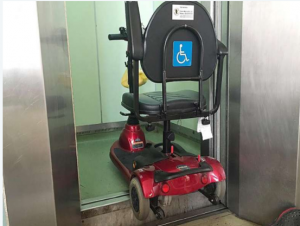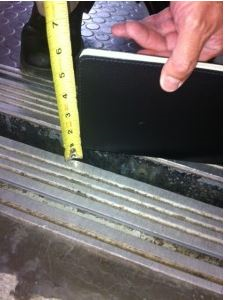Elevator car misaligned with landing floors
- Causes
1. Variation of load condition
Different load condition (empty, partially or fully loaded) affect the ability of the brake to stop at constant level. Under typical loading condition, the brake tension springs have been set to stop the car at the landing floor level. Nevertheless, a heavier load car will cause the car to slide a little further passing the floor level and lighter load will stop prior to landing floor level. Similarly, different levelling applies when the car is empty and fully loaded.
2. Environmental condition
The weather condition affects the brake to stop at consistent level. In warm and humid condition, the brake drum can be wet and the moisture act as a lubricant on the brake shoes and the linings causing the brake to slide.
3. Condition of brake linings
Where the condition of the machine room is warm and humid, the brake lining can absorb moisture and swell under humid condition, or alternatively become brittle and dry. This circumstances affect the ability of the car to stop at consistent level.
4. Life usage of elevator
Ageing elevator components such as brake drum and brake shoes will affect the ability of the car to stop at consistent level.
5. Wrong tension in main rope due to wrong design or requires re-levelling after certain interval.
6. Landing floor or flooring is not accurate.

Poor levelling can cause trip hazard [2]

Elevator car misaligned with landing floors [3]

Level difference
- Description of defect
Misalignment will not only cause injuries to the passengers as they tripped upon entry and exit but it can also cause serious injuries and even death especially to the elderly, wheelchair users and other mobility impaired persons
- Diagnostic/testing method
Inaccurate levelling floor may not purely inconvenience to elevator passengers but it is significantly hazardous particularly for the infirm or partially sighted. For the wheelchair users, who usually enter the elevator backwards, this fault can put them in a risk. Older elevators tend to have this problem and the levelling should be reviewed ensuring the value is acceptable by standards to avoid risk of tripping and falling of passengers while using the service

Inspection work to check levelling of elevator car and landing floor [4]
- Good practices
The stopping accuracy of the elevator shall be less than 10 mm, and the levelling accuracy shall be maintained at less than 20 mm (EN 81-70:2003). Proper maintenance contract will prevent this problem from occurring.
- Corrections
Upgrade the control system, braking and motor types. Instead of using the brakes to stop the car, modern elevators use the control systems to stop the elevator under any loading conditions. Micro-processor controller will electronically monitor and control motor rotation to ensure the elevator car accurately stop at floor level. As the car approach to stop, the motor controller will hold the car at the floor, and the brake will only act as a holding device as the car stopped and levelled, in order to maintain the car’s position. It is not only prevent the problem of misaligned, but also minimise the wearing of brake linings [5]